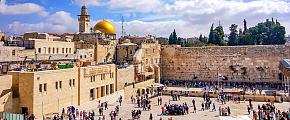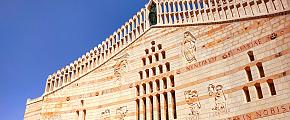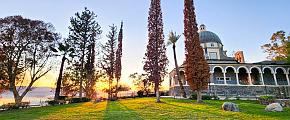Northern Israel and the Jesus Trail
So, another Christmas has come and gone. They seem to turn up more quickly each year! I hope everyone who celebrates the holiday had a wonderful time. Right now, (I'm writing this on Boxing Day) the small town of Bethlehem in the West Bank is crammed with visitors who have come here to celebrate Christmas in what is described as Jesus's birthplace in two of the Gospels, those of Matthew and Luke; the other two make no mention of any birthplace and historians and biblical scholars are divided on the issue as they are on so many others. Wherever he was born, it is a firm part of the tradition at least that it was Bethlehem. I wrote about Bethlehem in my previous article, Introducing Israel: Tel Aviv, Jerusalem, and Bethlehem. This time, I want to look more at northern Israel which is more certainly where Jesus grew up and started his ministry. Many people start thinking about their travel plans for the New Year around now, so hopefully, you will be inspired to consider a trip to the Holy Land next Christmas or at any other time of the year.
Although I'm going to be mainly describing and introducing sites and destinations important to Christian believers, that doesn't in any way have to deter travelers of other faiths or no faiths. These sites are interesting historically and culturally whatever your personal beliefs are.
We begin, of course, in Nazareth where Jesus's earthly parents Joseph and Mary lived and where he spent his childhood. From here we will visit several sites on so-called Jesus Trail (שביל ישו) which covers many of the sites of events documented in the Gospels. The 65km / 40 mile trail can be walked in stages, as Jesus would have done, and many visitors and pilgrims choose to do so. The hikes between start and finish take at least four days. Of course for the less mobile, the main sites can also be visited by other, less strenuous, means of transport.
NAZARETH
Today, Nazareth (Arabic: النَّاصِرَة; Hebrew: נָצְרַת) is Israel's largest Arab populated city and is often termed "the Arab capital of Israel". Its population in 2018, the date of the last census, numbered 77,064, 69% of whom were Muslim and 30.9% Christian. The neighboring, but separate city of Nazareth Illit (Upper Nazareth) was home to 40,312 Jewish residents (2014 figures).
The Jesus trail starts here in Nazareth at The Church of the Annunciation (Hebrew: כנסיית הבשורה), believed by Catholic Christians to be built on the site of Mary's home and where the angel Gabriel visited her to announce to her that she was to miraculously conceive and bear "the Son of God", despite being a virgin.
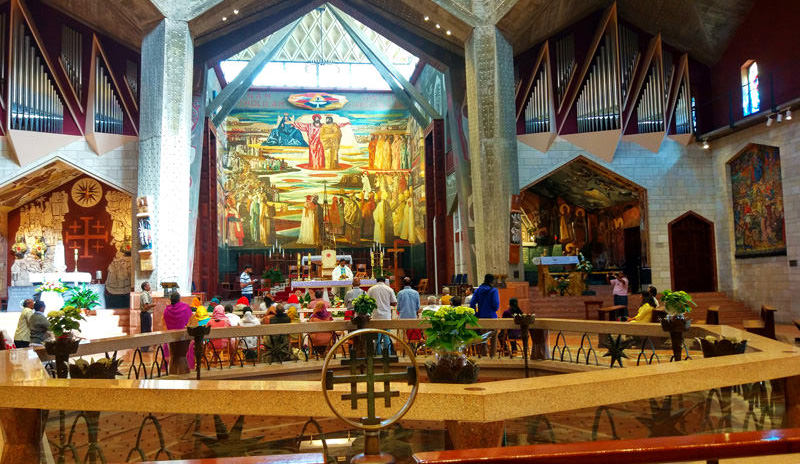 The Church of the Annunciation
The Church of the Annunciation
The Greek Orthodox Church disagrees with the location and places the Annunciation at another nearby site where Mary was drawing water from a spring when Gabriel appeared – Mary's Well (Arabic: عين العذراء) marks the spot. Beside the well, is the Greek Church of Saint Gabriel.
The Catholic church you see today was built as recently as 1969, but on the site of previous churches built in the Byzantine and Crusader eras. In the lower level of the church is the Grotto of the Annunciation, believed by devotees to be the site of Mary's home. Inside the church is a gallery of mosaics from around the world, all depicting Mary, while the church doors are decorated with carved scenes from the life of Jesus.
The nearby St. Joseph's Church, built in 1914, again over much older churches, is believed to be the site of Joseph's carpentry workshop.
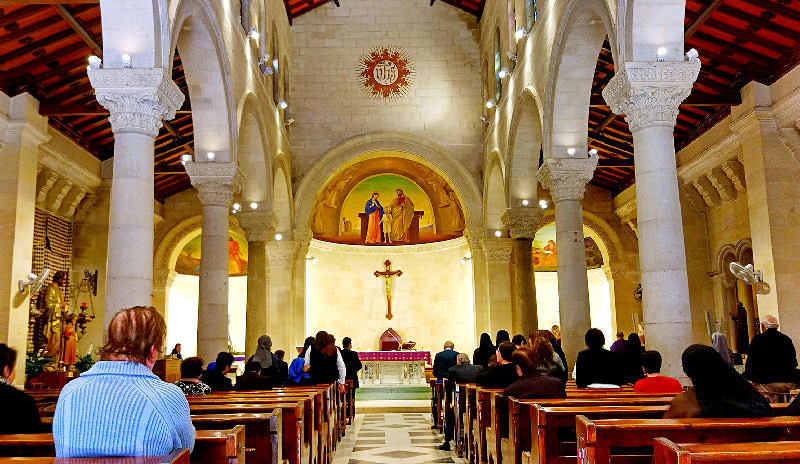 St. Joseph's Church
St. Joseph's Church
Also nearby, can be found the small Synagogue Church, supposedly built on the ruins of the synagogue where Jesus was said to have preached and declared that "that a prophet hath no honor in his own country" (John 4.44). He was said to have been marched from here to be thrown off a cliff at Mount Precipice (Hebrew: הר הקפיצה; Arabic: جبل القفزة), "But he passing through the midst of them went his way" (Luke 4. 30). The mountain is about 2 km / 1¼ miles southwest of Nazareth city center.
Of course, Nazareth is not only about Christian and Biblical sites. The White Mosque (Arabic: المسجد الأبيض, Hebrew: המסגד הלבן), completed in 1808, is the oldest in Nazareth. The lovely building, with its cream-colored walls with green trim is an active mosque attracting up to 3,000 worshipers on Fridays, Islam's most holy day.
KAFR KANNA
10 km / 6 miles by car or 8km / 5miles on foot from Nazareth we reach Kafr Kanna (Arabic: كفر كنا, Hebrew:כַּפְר כַּנָּא), believed to be the biblical Cana, site of the miracle of changing water into wine at the Marriage at Cana as described in John 2.1–12. There three main churches here: The Catholic Wedding Church, The Greek Orthodox Church of St. George and a Baptist Church. The normally closed Roman Catholic Chapel of the Apostle Bartholomew (aka Nathaniel) is dedicated to Bartholomew, one of Jesus's apostles who was said by John to have been born here.
THE MOUNT OF BEATITUDES
Another 40.5 km / 25 miles by road or 38km / 24 miles brings us to The Mount of Beatitudes (Hebrew: הר האושר), believed to be the site where Jesus gave the Sermon on the Mount, one of the most beautiful passages in the Bible, even for non-believers. Taking up chapters five, six and seven of Matthew, the sermon includes the Beatitudes and the Lord's Prayer.
Also known as Mount Eremos, the hill has a Roman Catholic Franciscan chapel, built between 1937 and 1938 and also offers wonderful views of the Sea of Galilee below. There are other contenders for being the site of the sermon, but this one has had the most support, going back around 1,600 years.
CAPERNAUM
Heading down from the mount, we find ourselves in the long abandoned fishing village of Capernaum (Hebrew: כְּפַר נַחוּם, Arabic: كفر ناحوم), which is said in the Bible to be the home towns of the apostles Matthew, James, John, Andrew and Simon Peter. Some believe Jesus made his home here as a young man and several mentions in the Bible suggest that he not only preached here, but performed several healing miracles in the village, such as described here in Luke, Chapter 4
38 And he arose out of the synagogue, and entered into Simon's house. And Simon's wife's mother was taken with a great fever; and they besought him for her.
39 And he stood over her, and rebuked the fever; and it left her: and immediately she arose and ministered unto them.
There are a number of interesting archaeological sites and remains in Capernaum, including a partially restored synagogue built in the 4th or 5th centuries, making it one of the world's oldest synagogues. Also, the remains of a number of houses built around a courtyard have been dated to the 1st century, one believed by some to be the home of the apostle Peter, although there is little real evidence of that. In 1990, a church, known as The Memorial was built over the home, but the remains of the foundations of the house and of a neighboring octagonal, Byzantine church can still be seen through glass floors.
TABGHA
Tabgha (Arabic: الطابغة; Hebrew: עין שבע,), an area on the sea of Galilee near Capernaum and is believed to be where Jesus performed the miracle of the loaves and fishes as described in Mark 6.30–6.46. This miracle is commemorated by the Catholic Church of the Multiplication of the Loaves and Fish, often referred to more simply as the Church of the Multiplication. The church we see today was built in 1984 to the identical floor plan of a previous 5th century Byzantine church on the same site. The builders also incorporated some of the remains of the older building, so some ancient black basalt walls can still be seen. The church also contains some of the oldest Christian themed floor mosaics in the world. In front of the altar is a mosaic showing two fish and a basket containing four loaves of bread.
Nothing to do with religion, but of great interest to scientists, environmentalists and nature lovers in Tabgha, is Tabgha Pool, a 4th century, octagonal Byzantine water tower which collects water from Ein-Nur, a warm sufuric, saline spring, which is home to unique critically endangered blind shrimp, Typhlocaris galilea
THE SEA OF GALILEE
I've mentioned the Sea of Galilee (Hebrew: יָם כִּנֶּרֶת, Arabic: بحيرة طبريا) a few times already, but its importance in the Bible merits looking closer. This is the sea (actually a lake) where Jesus found his first apostles and where he walked upon the water.
Also known as Lake Tiberias, Kinneret or Kinnereth, it is between 215 meters / 705 ft and 209 meters / 686 ft below sea level making it the lowest freshwater lake in the world. Only the Dead Sea is lower, but it is, of course, a saltwater sea. Mainly fed by the River Jordan which runs through it from north to south, the Sea of Galilee has an area of 166.7 km2 / 64.4 sq miles. In 1986, two fishermen brothers from a nearby kibbutz found what is now known as the Sea of Galilee Boat or Jesus Boat, a 8.27 meter / 27 foot long and 2.3 meter / 7.5 foor wide 1st century fishing boat, probably similar to those used by the fisherman apostles. There is no evidence linking the boat to Jesus or any the apostles, though. The boat and associated displays can be seen at Yigal Allon Centre in nearby Ginosar. The centre museum is open 08:00 to 17:00, Sunday to Thursdays, 08:00 to 16:00, Fridays and Saturdays, by appointment only. Address: The Yigal Allon Center, Kibbutz Ginosar 14980. Tel: 04-6727700. There is an admission charge, but unfortunately their website doesn't currently give it. Inquire locally if you are interested.
Besides the mostly Christian sites I have described here, northern Israel is a land of great beauty with great bird-watching locations and mountain views. Hiking and cycling here are very popular, but for the less energetic, cars or buses are the best way to get around. The road network is more developed than rail, but remember than most public transport does not operate on the Sabbath. There are trains from Haifa, northern Israel's largest city, but these mostly run down the Mediterranean coast. East-West routes are not well developed. From Tel Aviv to Nazareth, it is best to take the train to Haifa, then bus to Nazareth; by car is more direct and quicker, taking around 1½ hours, depending on traffic. Jerusalem to Nazareth by train is more difficult as you first need to go to Tel Aviv and then change; it's about two hours by car.
At present the only airport in northern Israel is Haifa Airport (Hebrew: נְמַל הַתְּעוּפָה חֵיפָה) (IATA: HFA) but it only really does domestic flights apart from a few charter services to Greece, Cyprus and Jordan.
But don't let transport difficulties worry you too much. Here at Odynovo, we supply private guides and drivers to nearly all destinations we operate in, including Israel. If you would like to visit this area of Israel or any others, please just let us know and we'll send you a free custom-designed itinerary within 24 hours, for your consideration. Alternatively, if you are not sure what you want, you can talk with one of our travel experts and they will be happy to share their suggestions, but in the end, we promise that you will decide the tour you want, not us.
Quick Question
What Our Clients Say
Explore the latest verified reviews of Odynovo's travel services on Tripadvisor, Google, Trustpilot, Product Review and more trusted platforms.
SUBSCRIBE TO WIN A FREE TOUR
Subscribe to our newsletter for a chance to win a free 7-day tour to India! And more insider travel news, exclusive offers, and inspiration will be sent straight to your inbox. Check our previous newsletters and get some sparks.

